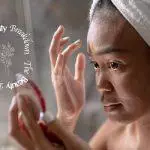Back in 2020, I wrote about “Zoom Dysmorphia,” a pandemic-born concept where people started to become hypercritical of their appearance on-screen, even on a tiny, pixelated corner square. Now, in 2022, this affinity for digital beauty has not only grown but graduated into a captivation with facial symmetry.
If you’re well-versed in the ebbs and flows of TikTok trends, you know exactly what I’m talking about. A quick search for #symmetricalface on the app garners 105 million views and an endless string of videos, in which users flip their faces back and forth with the app’s “inverted” filter—more often than not, they’re met with a strikingly different image…and a sense of panic.
I was all-too-familiar with these facial symmetry filters (and the anxiety they serve), but it wasn’t until I read about them in writer and editor Haley Nahman’s newsletter, Maybe Baby, that I reflected on our fascination with them as a collective beauty culture. I, like Nahman, was less than enamored by my own asymmetrical results. Great! Never doing that again, I vowed. Though that didn’t stop me from scrolling through the chasm of clips, one panic-stricken user after the other. If only a few individuals truly “passed” the symmetry test, why are we so captivated by this standard?
It turns out, our fascination with perfect symmetry might be a little overrated, anyway. Below, experts weigh in on the latest TikTok trend to sweep the beauty space.
The captivation of facial symmetry.
It’s more than just mere fascination with the intricate variances on the face: For many, it has become a fixation, often manifesting into cosmetic procedures like Botox, fillers, and plastic surgery. “Comment your plastic surgeon’s name below please,” one user wrote after displaying her results. Of course, the reasons someone might undergo a cosmetic procedure are very nuanced, and we’re not here to shame anyone for making that choice. But we also can’t ignore the rapid rate at which these procedures are climbing—and without technology like TikTok’s “inverted” filter, we might not have even noticed those deviations were even there.
“My practice has definitely seen an increase in inquiries for improving facial asymmetries,” says holistic plastic surgeon Shirley Madhère, M.D., founder of Jet Set Beauty Rx. “Younger patients have been requesting injectable fillers for evening out structural facial contours (without surgery), while more mature patients are more willing to invest in more definitive improvements that surgery may bring.” Both ventures are meant to alter your appearance, and both, Madhère predicts, are byproducts of our filtered reality.
“Filters used on various social media platforms allow the opportunity for us to see ourselves as we perceive ourselves or wish to be seen,” she adds. “Unfortunately, however, these tools are often dimensionless.” The reason we even have facial features to begin with is to communicate with others and relay emotion and information—when you peer into a screen, you don’t have that social context, so it’s easier to evaluate so-called flaws on a one-dimensional plane.
While TikTok filters are a big slice of the pie, other pandemic-inspired shifts have a stake as well. “I believe this is multifactorial, including the various inverted filters being used on TikTok and Instagram, Zoom meetings, and now with masks being removed after two years,” says holistic plastic surgeon Anthony Youn, M.D. Again, “Zoom Dysmorphia” is very much real; a 2020 survey in the journal Facial Plastic Surgery & Aesthetic Medicine even found that 40% of respondents who had never tried cosmetic procedures before planned to pursue treatments based on their video conference appearance. In short: We’re staring at our faces more than we ever have before, which gives us ample opportunities to scrutinize our features.
But in reality, we are drawn to asymmetries.
But you see, facial features are meant to be dynamic! Again, the reason we even have them is to communicate our emotions and recognize each other—they are what make us social beings. So while you might want to look perfectly symmetrical on screen, in real life, your intricate asymmetries are what makes you, well, human. It’s why many people actually find beauty in the unique differences on the face, like a crooked smile or the way someone’s left eye might crinkle when they laugh. Nahman even references a study showing humans are more attracted to asymmetries.
OK, yes, research also has associated symmetrical faces with the standard of beauty, but I’d argue this standard sits on a bell curve—there’s no way those studies could have predicted people could (and would) mold their faces to be completely, 100% symmetrical. Take the age-old “golden ratio” theory, for example, which proposes facial proportions of 1.618 are most pleasing to the eye. There’s even a golden ratio filter on TikTok you can play around with to see how your facial features measure up (another panic-inducing filter). It’s become somewhat of a micro-trend to distort your face to these dimensions; creators also edit the faces of well-known public figures to match this golden ratio, and the results look…a little off.
Perhaps it’s because a perfectly symmetrical face might take away some of the unique essence that helps us recognize these individuals, and thus a layer of vulnerability. Those asymmetries we’re used to, however, make a person much more inviting. “They’re a little bit more expressive, a little bit more personal, a little bit more intriguing,” says psychologist Chloe Carmichael, Ph.D., who works with a host of clients struggling with perfectionism. “They tell more of a story.” In this case, erasing the asymmetries is akin to starting with an eerie blank page.
This notion that your face tells a story also stems from Eastern medicine: “Our face represents our past,” says skin care expert Debbie Kung, DAOM, LAc. “We carry the face of thousands of generations that come before us that have survived so that we were born… In Eastern culture, we look at the face you’re born with like your destiny. And it’s a good thing—it’s not something you should be ashamed of.” If you do alter a feature on your face, Kung adds, you might alter your destiny, too—which isn’t always the best move.
Kung practices facial rejuvenation with cosmetic acupuncture, which does address facial symmetry to some degree; but it’s less about molding the actual facial features and more about whole-body balance since what shows up on your face reflects what’s going on in your organ system. “We work on certain muscles with the face that can actually lift the brows, so your eyes do look bigger because the eyelids aren’t as heavy. But in terms of the actual facial features, we honor that,” Kung explains. “[Cosmetic acupuncture] helps to boost the fibroblasts in your dermis to help build collagen, and it does so many things to help ‘even you out.’ It makes you look like your best self, but it’s not going to make you look like a filter.”
Even plastic surgeons don’t actually aim for perfect symmetry in their work. “As in life in general, perfection is a myth. Plastic surgeons do not aim for perfection, just close to it,” says Madhère. Again, a perfectly symmetrical face can look a bit uncanny, as a filter-like facade doesn’t honor a 360-degree harmonious look. Just think about the filters themselves: They only work while you look straight into the camera—as soon as you sport a wide grin or turn your head a bit too far, the image becomes warped. Youn concurs: “Everyone has facial asymmetry to some degree, and to expect that your face should be perfectly symmetric is not realistic or being kind to yourself. Sometimes we can reduce the asymmetry, but it can never be fully ‘corrected.'”
Although, aiming for facial symmetry has always been part of the beauty culture conversation. Let’s say you tweeze and shape your brows to resemble each other or tightline your upper waterline so both eyes appear more open—that’s technically aiming for symmetry, to some degree. So how far is too far?
The answer is up to the individual, of course, as there’s no specific benchmark. And at the end of the day, you are the expert on your own face, and you can do with it how you please. According to Carmichael, it’s also less about the actual procedures than the satisfaction you feel after the fact. Some people undergo plastic surgery and are truly able to move on with their lives—again, we’re not against all cosmetic procedures, here. But that’s a completely different scenario than someone who can always find just one more thing to correct. “The rule of thumb is to ask yourself if this is some kind of a pattern where you feel like you’re never satisfied, almost like you’re picking at yourself,” says Carmichael.
And if you are struggling with this pattern, she does offer a few tips to exit the cycle. One exercise? Try to name five features about the other person’s face as you’re talking to them. “If you’re obsessing, wondering if they’re noticing the asymmetry in your eyebrows, try to force your mind to focus on the other person,” suggests Carmichael. “Silently name five features about them.” There’s a very good chance you won’t point out any of their asymmetries.






